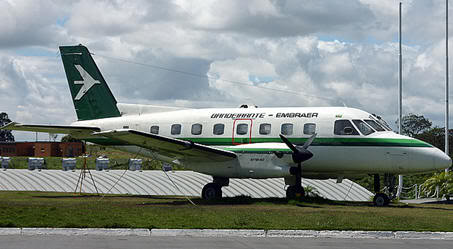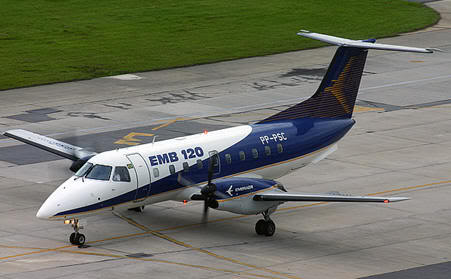
|
|
Embraer EMB-110 "Bandeirante"
Embraer EMB-110 was the first commercial aircraft
from Embraer. The history began in 1965 when the Air Ministry started a
project to build a commercial and military aircraft. The first prototype
(EMB-100) was built in three years and four months,
designed by Max Holste. The first flight was on October 1968.
Only three units were produced, because it got some improvements and
became the EMB-110, commonly known as "Bandeirante". The word came from
the name given to the Portuguese colonists, who expanded the borders of
Brazilian territory, part of the Portuguese Empire. The Embraer 110 is
also known abroad Brazil as "Bandit".
The first EMB110 Bandeirante flew for the first time in August 1972 and
entered commercial operation in April 1973 by Transbrasil. But it main
order was from Brazilian Air Force, which ordered 80 units and
secured the return of the project.
In 1977 occurred the first delivery to a foreign airline: Air Littoral.
In June 1978 Aero Commuter ordered three aircraft.
The EMB-110 was a low cost and economic aircraft and was successful in
Brazil and abroad, receiving orders on five continents. Embraer has also
released several versions of the EMB-110. The most different is also
known as "Bandeirulha" or EMB-111, and it is used for transporting
passengers, cargo, rescue and photo reconnaissance.
Embraer would release new versions of the EMB-110, but dropped the
project to focus on building the new EMB-120. The last EMB-110 was
delivered in 1995 for the Brazilian Air Force.
Versions:
EMB-100: equipped with Pratt & Whitney Canada PT6A-20 and had a capacity for eight passengers.
EMB-110B: military version to take pictures. Equipped with cameras and carry up five passengers.
EMB-110B1: with alternative rapid conversion and capacity for up 14 passengers.
EMB-110BI: executive version for special missions to aerial photography, with a capacity of nine passengers.
EMB-110C: civil version with 12, 15 or 16 seats.
EMB-110C(N): with anti-freeze equipment.
EMB-110E: privet version with six or eight seats.
EMB-110K1: military version, equipped with Pratt & Whitney Canada PT6A-34, rear cargo door and an extra port for passengers and crew.
EMB-110P: civil version of the EMB-110K1 with 18 seats, equipped with Pratt & Whitney Canada PT6A-27 or PT6A-34.
EMB-110P1: quick change version for passenger/cargo of the EMB-110P.
EMB-110P2: quick change version for passenger/cargo of the EMB-110P, with up to 21 seats and no cargo door.
EMB-110P1SAR: SAR version with accommodations for six stretchers and maximum weight of six tonnes.
EMB-11OS1: Version Geophysical surveys to conduct remote sensing operations, based on the EMB-110C.
Operators in Brazil:
Tam,
TransBrasil, Rio Sul,
Nordeste, Rico,
Abaeté, Meta
 Origin:
Brazil
Origin:
Brazil
Produced: 1971 - 1991
Length: 15.33 m
Wingspan: 15.10 m
Height: 4.92 m
Aircraft Weight: 3.39 tons
Maximum Takeoff Weight: 5.9 tons
Engines: 2x P&W Canada PT6A-34F
Cruising Speed: 341 km/h
Maximum Speed: 425 km/h
Service Ceiling: 6.55 km (21,500 ft)
Takeoff Run: 375 m
Range: 785 to 1450 km
Passengers: 12 to 22
Crew: 2
First flight: August 16, 1968
Delivered: 501
Launch Customer: Transbrasil
After the success of EMB-110,
Embraer started a new larger and pressurized aircraft project. The
aircraft would be based on EMB-121 Xingu, but Embraer decided to produce
a totally new aircraft.
The EMB-120 (also known as “Brasília”) was born in 1979. When the
prototype made
its
first flight, the model had already more than one hundred orders. Unlike
Bandeirante, who began its career in Brazil and then was exported,
Brasília entered in service first for a foreign airline. ASA was the
launch customer and received its first EMB-120 in October 1985.
Other versions of the EMB-120 were made, like the EMB-120RT with lower
takeoff weight, EMB-120ER with greater range, EMB-120FC only for cargo,
EMB-120QC easily converted to cargo or passenger and VC-97 for privet or
military transport.
Like the EMB-110, EMB-120 was successful and allow Embraer launch its
first jet, the ERJ-145.
When ERJ Family entered in service, EMB-120's sales were falling.
However, the production line is not closed yet.
Operators in Brazil: Air Minas, America Air, Meta, Nordeste, Interbrasil, OceanAir, Pantanal, Passaredo, Penta, Rico, Rio Sul, TAVAJ
|
|
Origin:
Brazil
Produced: 1985 - today
Length: 20.07 m
Wingspan: 19.78 m
Height: 6.35 m
Aircraft Weight: 7.07 tons
Max Takeoff/Landing Weight: 11.5/11.2 tons
Fuel Capacity: 3280 liters
Engines: 2x Pratt & Whitney PW118B
Cruising Speed: 555 km/h
Maximum Speed: 620 km/h
Service Ceiling: 9.08 km (29,800 ft)
Takeoff Run: 1.42 km
Range: 1556 to 1750 km
Passengers: 20 to 35
First flight: 1983
Delivered: 352
Launch Customer: SkyWest Airlines

